1919Discovery
A Japanese chemist first synthesizes amphetamine in a lab. During World War II, the Japanese and Germans use the drug to keep tank drivers awake and increase workers' productivity.
1960s -1970sEarly Users
Amphetamine, popularly known as speed or uppers, becomes known as a drug used by athletes, college students, motorcycle gangs and truck drivers.
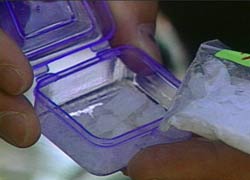
Meth in crystal form.
1980Crystal Meth: Twice as Potent
Amphetamine's key chemical, Phenyl-2-propanone, is put under federal control.
However, the cooks making the drug for West Coast motorcycle gangs discover that ephedrine -- an ingredient found in over-the-counter cold remedies -- produces methamphetamine, better known as crystal meth, and it is twice as potent.
And, unlike other hard drugs such as cocaine and heroin, crystal meth can be made from household products. The only essential ingredient is ephedrine, or its cousin, pseudoephedrine, also found in many cold medicines.
"From a chemical perspective, methamphetamine is amphetamine with a methyl group, if you're interested in the science of it. But it's pretty much like a high-octane gasoline versus a low-octane gasoline. Methamphetamine, of course, is the high-octane version." - Rob Bovett, Oregon Narcotics Enforcement Association
Early 1980sEnter the Cartels
Mexican drug runners begin supplying ephedrine to the biker gangs' cooks. Within a few years, Jesus and Luis Amezcua, Mexican cocaine traffickers, become top meth dealers.
Home meth labs also begin spreading throughout the West Coast where cooks make the drug from household products such as paint thinner, acetone, and battery acid.
1986First Attempt to Stem Meth
The DEA's number three man, Gene Haislip, authors legislation requiring companies making 14 kinds of chemicals used in making illegal drugs -- including ephedrine and pseudoephedrine -- to keep sales and import records. The bill would affect sellers of nonprescription asthma and diet pills containing ephedrine, and even more importantly, it would also affect makers of cold medicines containing pseudoephedrine, a $3 billion market. (Ephedrine and pseudoephedrine are interchangeable for making meth.)
The pharmaceutical industry mounts a strong lobby against the proposed regulation.
" … in the protection of the public interest, there were two competing goals: keeping the ingredient in the hands of the American consumer, but keeping it away from the criminal. We all thought we could find a way to do this, but unfortunately we felt DEA was confused about who was the bad guy." - Allan Rexinger, former lobbyist for the pharmaceutical industry.

Raw powder in bulk.
1988A Compromise With a Loophole
The pharmaceutical industry and the DEA agree on a compromise version of the DEA's proposed regulation two years earlier, and the bill is passed. However, it exempts from regulation any chemical -- such as ephedrine and pseudoephedrine -- turned into a legal drug product. Importers of raw ephedrine and pseudoephedrine powder will have to keep records of their purchases and sales. Sellers of finished pills containing the chemicals will not.
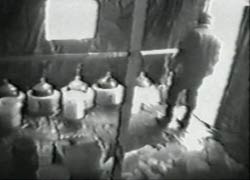
Surveillance footage of a "super lab" in California's Central Valley.
Early 1990sMeth Explodes
The meth cooks switch to using pills, since pill form cold medications containing ephedrine/pseudoephedrine remain unregulated.
The Amezcua cartel in Mexico develops an additional source for ephedrine, buying bulk ephedrine powder overseas from some of the same nine factories (in Germany, Czech Republic, China, and India) from which the American pharmaceutical industry buys their supply of ephedrine/pseudoephedrine for cold medicines. Meth's purity doubles, and a flood of meth spreads eastward from the West Coast. The number of people entering rehab for meth skyrockets.
Robert Pennal, head of the Fresno (Calif.) Methamphetamine Task Force, starts seeing large meth labs in California's Central Valley. Four out of every five hits of meth consumed in the United States are coming from these industrial-scale labs.
"The Amezcua brothers revolutionized the meth trade. They turned it from a small mom-and-pop backyard operation to an industrial-scale production line. They made possible the super lab, which is capable of producing 1,500 times what an ordinary user can make for himself." - Steve Suo, investigative reporter for The Oregonian
March 1994Accidental Discovery
A U.S. customs agent inadvertently discovers 3.4 metric tons of ephedrine on a plane traveling from Switzerland to Mexico. The powder comes from a factory in India, and the Amezcua cartel's source is exposed. The DEA learns that during one 18-month period, the Amezcua brothers smuggled 170 tons of ephedrine to the United States, enough for 2 billion hits of meth.
The United States asks foreign manufacturers to cease ephedrine exports to the cartel. The chemical becomes more scarce, and meth's purity on America's streets starts to plunge.
April 1994-August 1995Another Loophole for Traffickers
Legislation passed in 1993 goes into effect in phases, requiring ephedrine pill sellers to register with the DEA, keep sales records, and report suspicious customers. However, the bill does not cover sellers of pseudoephedrine pills.
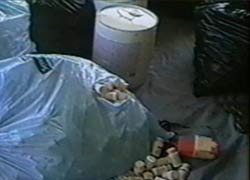
Pill bottles confiscated from a meth lab.
1995Dangerous Business
Meth cooks switch to using the unregulated pseudoephedrine pills, but the pills need to be broken down to remove the key ingredient. The cooks add flammable chemicals to the process, making their already toxic labs more susceptible to explosion.
"Before you know it, 60 percent of the labs we were dealing with were [having] fires and explosions, because they were learning, and they were making mistakes." - Robert Pennal, Fresno Meth Task Force
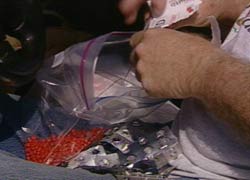
Removing pills from blister packs (AKA "smurfing").
1996Yet Another Loophole
After the DEA reaches a new compromise with the pharmaceutical industry, Congress passes a law regulating pseudoephedrine sales. Wholesale distributors of over-the-counter cold medicines would have to register for a DEA license. However, the law exempts from regulation cold remedies sold in foil "blister packs," which are considered harder for meth cooks to open in volume. (Within three years, blister packs of pseudoephedrine will be found in 47 percent of seized meth labs.) In addition, the deadline for distributors to start registering with the DEA is pushed back a year.
"… essentially the decision was made to give everyone a year to adjust to the new controls. Well, look, that … gave the traffickers a year to adjust, and that's just what they did." - Gene Haisllip, DEA Office of Diversion Control
| Read "Lobbyists and Loopholes," Part Two of The Oregonian's award-winning series on meth dealing with the pharmaceutical industry's opposition to regulation.
1997Bogus Fronts Supply the Trade
By the time the new DEA licensing law goes into effect in late 1997, meth traffickers have completed their switch to using pseudoephedrine. And the DEA is swamped by thousands of bogus companies applying for licenses and, short on staff, it begins issuing temporary permits. Before long, companies licensed by the government are making millions selling pseudoephedrine to the super labs.

A train crossing the U.S.-Canada border.
1998The Cartels' Reach
In June, Mexican authorities arraign Jesus and Luis Amezcua on charges of money laundering and racketeering. At the time, the DEA estimates they control 80 percent of the American methamphetamine market. The DEA has also found evidence that several other major Mexican cartels are now trafficking meth.
| Read more about Mexican Meth.
1999-2001The Canadian Connection
Meth cooks in the Central Valley begin to grow desperate as the DEA tracks down the last bogus companies selling pseudoephedrine to meth labs. However, it takes two years before the DEA discovers the traffickers are getting a new supply of pseudoephedrine from bogus pharmaceutical companies in Canada, where pseudoephedrine is unregulated. Over a period of four years, Canada's bulk pseudoephedrine imports for the manufacture of cold pills quadruple.
"[W]e start finding these 60-milligram, 1,000-count white bottles with no markings on them. … There was some writing in French, and it would identify Canada. … we're finding them everywhere. … it's almost like a newsletter is sent out to the whole network of cookers, and they'd make this transition all at one time." - Robert Pennal, Fresno Meth Task Force
2003U.S. - Canadian Crackdown
Canada successfully curbs imports of pseudoephedrine to U.S. meth labs by adopting a licensing system similar to the United States'. Canadian law enforcement teams up with the DEA to make arrests in 10 cities and bring charges against three Canadian chemical companies.
"The [Royal] Canadian Mounted Police would pursue these loads of pseudoephedrine from Ontario, follow it all the way up to the border at Detroit and hand off the surveillance to the DEA, which would pick it up and follow it all the way across the country to California, where they in some cases actually were able to pursue the loads up to meth labs and then shut them down." - Steve Suo, investigative reporter for The Oregonian.
The number of super labs in California drops, but more labs open in Mexico. A 2003 National Survey on Drug Use and Health estimates 12 million Americans over the age of 12 have tried methamphetamine in their lifetimes.

The U.S.-Mexico border.
2004The Meth Battle Heats Up
Mexico legally imports 224 tons of pseudoephedrine -- twice as much as they need to make cold medicine. The extra 100 tons is cooked into meth, then smuggled, like other drugs, across the border into the United States. As a result, meth on American streets is as pure as it's ever been.
The president's Office of National Drug Control Policy (ONDCP) releases its National Synthetic Drugs Action Plan, [PDF] summarizing the progress and concerns in battling methamphetamine, MDMA (Ecstasy) and other club drugs.
In April 2004, Oklahoma becomes the first state to pass a law placing limits on sales of pseudoephedrine to pharmacies and requiring retailers to sell pseudoephedrine products from behind the counter and ask purchasers to show I.D. and sign a register. (In previous years, the pharmaceutical industry had opposed similar legislation in Oregon, and it was defeated.)
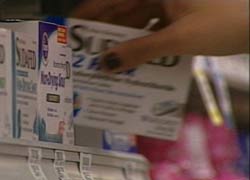
Over-the-counter pseudoephedrine-based cold medicines.
2005State/National/International Initiatives
To curb home-lab meth production, more than 35 states have passed legislation restricting sales of pseudoephedrine in some way, either by placing limits on the amounts purchased, requiring that the drug be sold within a certain distance from the register, requiring customers to request the item from behind the counter or from a locked case, or requiring them to sign a registry.
At the urging of its Meth Caucus, Congress passed the Combat Methamphetamine Epidemic Act of 2005 as part of the PATRIOT Revision Act. This legislation mandates that pseudoephedrine be put under lock and key in stores nationwide and that buyers register at the store counter. It will also toughen penalties against meth traffickers and enhance the government's authority to stem the flow of precursor chemicals (ephedrine/pseudoephedrine) from foreign manufacturers.
July 2005
Deputy drug czar Scott M. Burns testifies that the administration's "strategy to reduce drug use in America is not focused on one illicit drug at the expense of another, but seeks to reduce all illicit drug use. However, officials at ONDCP, the Department of Health and Human Services, and the Department of Justice realize that methamphetamine, illicitly used prescription drugs, and club drugs -- collectively referred to as synthetic drugs -- pose a unique challenge, and constitute an emerging problem."

A pharmacy in Mexico.
November 2005
The Mexican government admits that drug cartels artificially inflated demand for pseudoephedrine and agrees to reduce imports to a level legitimately needed for cold medicine. Mexico will also allow only licensed pharmacies with full-time pharmacists to sell medicines containing pseudoephedrine, reducing the number of retail outlets selling the drug from 51,000 to 17,000.
"Mexico may well get ahead of this problem in a year or two down the line and greatly limit its pseudoephedrine imports, but there are a lot of other countries out there, and already we've seen spikes in pseudoephedrine imports in other countries, ... like Argentina, Colombia, [and] in the East Indonesia, Iran, without any particular explanation. So there are plenty of opportunities for the cartels to leapfrog around." - Steve Suo, investigative reporter for The Oregonian
2006The Most Abused Hard Drug on Earth
The U.N. World Drug Report calls meth the most abused hard drug on earth, and the world's 26 million meth addicts equals the combined number for cocaine and heroin users. America alone has 1.4 million users, and the number is rising; globally, the highest concentration of addicts is in East and Southeast Asia.
2009The Mexican Ban
The Mexican government recognizes there is a huge oversupply of pseudoephedrine coming into the country, and most of it is being diverted to the U.S meth trade. They decide to ban importation all together. With the Mexican cartels unable to get their hands on pseudoephedrine, the potency of the meth being smuggled into the U.S. plunges.
2009 California, Super Supplier
After Mexico's ban of pseudoephedrine, Mexican drug trafficking organizations look to California to ramp up meth production, knowing they can get supplies of pseudoephedrine throughout the West Coast. Unlike before, when super labs made 100 pounds or more in one reaction, meth is produced in smaller labs across multiple locations so that if one is taken down there is less at stake. California, known as a meth-exporting nation, is by some estimates producing more meth than the next five biggest producer states in the U.S. combined.
2010 Mississippi on the Ropes
In 2010, with a growing meth crisis on its hands and more dangerous meth-cooking practices, Mississippi becomes the second state after Oregon to make pseudoephedrine products prescription only. A few months after enforcing the law, officials see a sharp drop in meth lab seizures and meth-related crime.
| Explore Our Map: "Map Meth at the State Level" Which states have adopted some kind of law restricting the sale of pseudoephedrine?
2010 Is Meth a Nationwide Problem?
Telling lawmakers "Meth manufacturing is a scourge that has been all but eliminated in Oregon,” Senator Ron Wyden (D-Ore.) introduces legislation that would make pseudoephedrine a prescription drug nationwide. Law enforcement, and health and prevention groups support the measure.
2011 Lobbying the States
More than a dozen heartland and southeastern states hit hard by meth abuse, consider prescription-only legislation. But heavy lobbying by the pharmaceutical industry stymie their efforts. Other states struggling with the problem begin using electronic tracking systems to monitor behind-the-counter sales. Kentucky is the first to use the system and more than two years in, officials say it’s failing to bring rates down.
COMMENTS
blog comments powered by DisqusIn order to foster a civil and literate discussion that respects all participants, FRONTLINE has the following guidelines for commentary. By submitting comments here, you are consenting to these rules:
Readers' comments that include profanity, obscenity, personal attacks, harassment, or are defamatory, sexist, racist, violate a third party's right to privacy, or are otherwise inappropriate, will be removed. Entries that are unsigned or are "signed" by someone other than the actual author will be removed. We reserve the right to not post comments that are more than 400 words. We will take steps to block users who repeatedly violate our commenting rules, terms of use, or privacy policies. You are fully responsible for your comments.